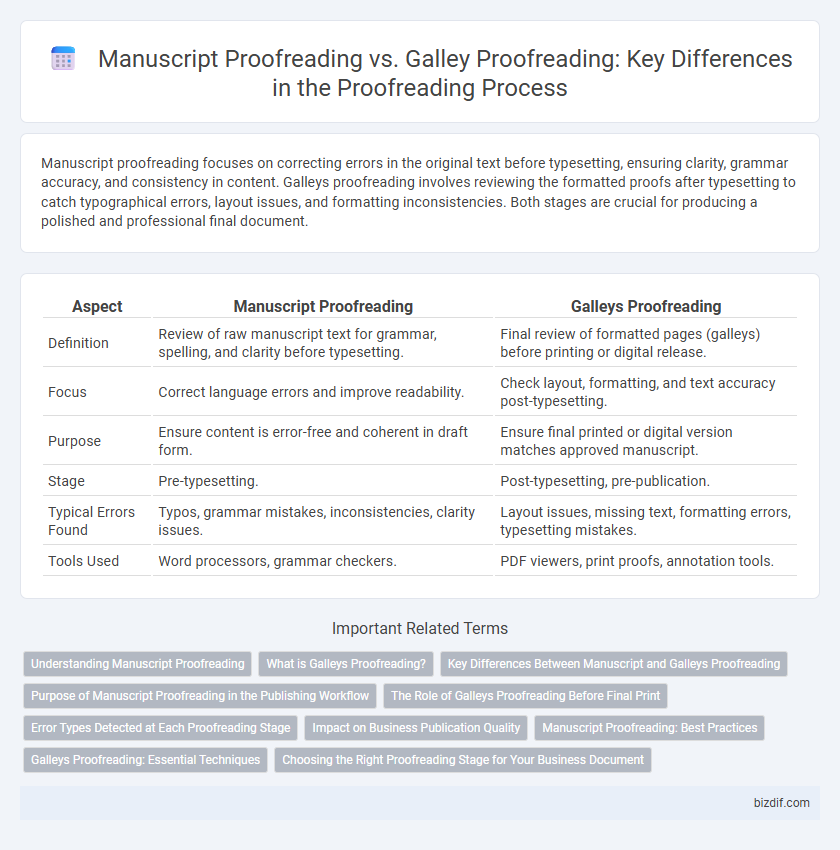Manuscript proofreading focuses on correcting errors in the original text before typesetting, ensuring clarity, grammar accuracy, and consistency in content. Galleys proofreading involves reviewing the formatted proofs after typesetting to catch typographical errors, layout issues, and formatting inconsistencies. Both stages are crucial for producing a polished and professional final document.
Table of Comparison
| Aspect | Manuscript Proofreading | Galleys Proofreading |
|---|---|---|
| Definition | Review of raw manuscript text for grammar, spelling, and clarity before typesetting. | Final review of formatted pages (galleys) before printing or digital release. |
| Focus | Correct language errors and improve readability. | Check layout, formatting, and text accuracy post-typesetting. |
| Purpose | Ensure content is error-free and coherent in draft form. | Ensure final printed or digital version matches approved manuscript. |
| Stage | Pre-typesetting. | Post-typesetting, pre-publication. |
| Typical Errors Found | Typos, grammar mistakes, inconsistencies, clarity issues. | Layout issues, missing text, formatting errors, typesetting mistakes. |
| Tools Used | Word processors, grammar checkers. | PDF viewers, print proofs, annotation tools. |
Understanding Manuscript Proofreading
Manuscript proofreading involves a detailed examination of a draft document to correct spelling, grammar, punctuation, and formatting errors before the text advances to the layout stage. This stage emphasizes clarity, coherence, and consistency, ensuring the author's original intent is accurately conveyed without stylistic or factual inaccuracies. Understanding manuscript proofreading is crucial for producing error-free, polished content that meets academic or publishing standards prior to galley proofs.
What is Galleys Proofreading?
Galleys proofreading is the process of reviewing the formatted version of a manuscript, known as galley proofs, which closely resemble the final publication layout. This step focuses on detecting typographical errors, formatting inconsistencies, and minor textual issues before the document goes to print or digital distribution. Galleys proofreading ensures that all corrections from previous editing stages are accurately implemented and that the final presentation meets publication standards.
Key Differences Between Manuscript and Galleys Proofreading
Manuscript proofreading involves reviewing the original text for grammar, spelling, punctuation, and consistency before typesetting, ensuring the author's intended content is clear and accurate. Galleys proofreading focuses on detecting formatting errors, typographical mistakes, and layout issues in the typeset proofs, verifying the final appearance matches the original manuscript. Key differences include the stage of review, with manuscript proofreading addressing content accuracy and galleys proofreading ensuring production quality before publication.
Purpose of Manuscript Proofreading in the Publishing Workflow
Manuscript proofreading in the publishing workflow focuses on eliminating grammar, spelling, and punctuation errors before the manuscript enters the formatting stage, ensuring clarity and accuracy in the author's original content. This step verifies consistency in terminology, corrects typographical mistakes, and improves overall readability to meet publication standards. By addressing these issues early, manuscript proofreading streamlines subsequent editing processes and reduces costly revisions during later production phases.
The Role of Galleys Proofreading Before Final Print
Galleys proofreading is a critical step that involves meticulously reviewing the formatted manuscript to catch typographical errors, layout issues, and inconsistencies before the final print. This stage ensures that the text, images, and design elements align perfectly, preventing costly mistakes in mass production. By focusing on galleys proofreading, publishers uphold the quality and professionalism of the final printed material, enhancing readability and overall presentation.
Error Types Detected at Each Proofreading Stage
Manuscript proofreading primarily detects errors in grammar, punctuation, spelling, and sentence structure to ensure clarity and correctness before layout. Galleys proofreading focuses on formatting issues, typographical errors, and discrepancies between the manuscript and final layout, including font consistency and margin alignment. Each stage targets specific error types to enhance both textual accuracy and visual presentation of the publication.
Impact on Business Publication Quality
Manuscript proofreading focuses on correcting grammar, spelling, and formatting errors in the initial draft, ensuring clarity and coherence that form the foundation of high-quality business publications. Galleys proofreading, performed on formatted page proofs, targets layout inconsistencies, typographical errors, and design flaws that directly impact the visual presentation and professional appearance of the final publication. Prioritizing both stages enhances overall publication quality, bolstering credibility, reader trust, and the brand reputation of business communications.
Manuscript Proofreading: Best Practices
Manuscript proofreading requires a thorough review of grammar, punctuation, and formatting errors to ensure clarity and coherence before submission. Best practices include reading the text aloud, using digital tools alongside manual checks, and focusing on consistency in style and citation formats. Early and meticulous manuscript proofreading minimizes costly revisions and enhances the overall quality of the final publication.
Galleys Proofreading: Essential Techniques
Galleys proofreading involves meticulously reviewing the formatted galley proofs to identify typographical errors, layout inconsistencies, and formatting issues before final publication. Key techniques include comparing the galley proof with the original manuscript to ensure accuracy, checking pagination and headers for proper sequencing, and verifying that all images and tables are correctly placed and labeled. This stage requires attention to detail to prevent costly post-publication corrections and maintain the publication's professional integrity.
Choosing the Right Proofreading Stage for Your Business Document
Manuscript proofreading focuses on correcting errors in the initial draft, ensuring the clarity, grammar, and structure of the content before any formatting begins. In contrast, galleys proofreading involves reviewing the formatted version, catching layout issues, typographical mistakes, and consistency errors that appear after typesetting. Selecting the appropriate proofreading stage depends on your business document's development phase and the level of precision required to present a polished, professional final product.
Manuscript Proofreading vs Galleys Proofreading Infographic

 bizdif.com
bizdif.com